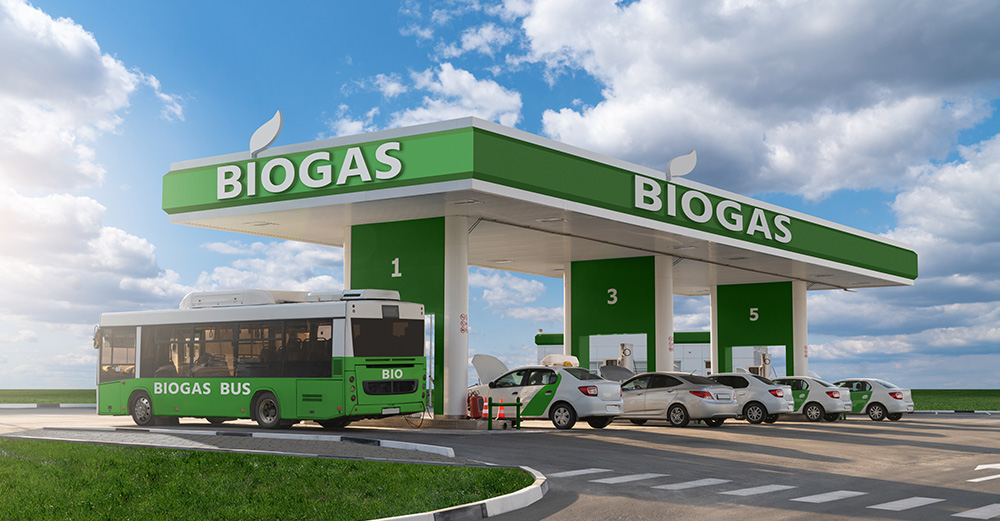Bio-CNG offers a transformative opportunity that goes far beyond decarbonization. It has the potential to integrate environmental sustainability with economic empowerment and rural development.

India is accelerating towards decarbonizing the transport sector with the nation standing at a pivotal juncture—challenged by a growing demand for mobility, increasing emissions, and the pressure to meet its climate commitments. While electric vehicles (EVs) dominate public discourse as the future of clean transportation, another promising solution is quietly gathering momentum: Bio-Compressed Natural Gas (Bio-CNG). For a country like India—with its vast agrarian base, abundant biomass, and a large rural population—Bio-CNG offers a transformative opportunity that goes far beyond decarbonization. It has the potential to integrate environmental sustainability with economic empowerment and rural development.
Every year, India produces immense volumes of organic waste. From cattle dung and crop residues to municipal solid waste, a large share of this biomass is either burned, dumped, or left to decay—releasing methane into the atmosphere. The environmental dividend of utilizing this biomass is compelling, given that methane is nearly 28 times more potent than carbon dioxide in causing global warming, over a 100-year horizon.
Against this backdrop, Bio-CNG makes a strong case for policy support
Produced through anaerobic digestion of animal and agricultural waste, Bio-CNG offers a credible pathway to substantially reduce greenhouse gas (GHG) emissions. Among all feedstocks, cattle dung emerges as the most promising—in terms of emission savings, availability, and ease of collection—in the India scenario. TERI’s assessment shows that Bio-CNG can achieve net-negative emissions, avoiding up to 1.141 kg CO₂ equivalent per kilometre for a 4-wheeler vehicle by saving emissions during the upstream fuel cycle. This negative emission outcome is a direct result of avoided methane leakage from unmanaged dung and avoided use of synthetic fertilizers, replaced instead by digestate generated from the digestion process. The biochemical process converts volatile solids into methane while leaving this nutrient-rich digestate in which a large fraction of nitrogen is present as plant-available ammonium, and phosphorus and potassium are largely conserved, making it an excellent organic fertilizer. This makes Bio-CNG not just low-emission, but an actual GHG mitigator as it avoids methane emissions from open dumping.
So, what does this hold for India?
Bio-CNG—where biomass is abundant—ensures that our mobility is not just cleaner, but also equitable, affordable, and resilient. For India, this is a climate strategy rooted not in futuristic technologies, but in everyday rural realities. Bio-CNG creates monetizable value streams–paid dung aggregation, plant operation and maintenance, transport, digestate processing, and manure commercialization. The technology is proven, and the potential is immense—but leveraging it at scale requires addressing a few structural hurdles.
Bio-CNG from cow dung can deliver a circular-economy win—recovering energy, lowering methane emissions, producing substitute fertilizer, and creating rural incomes—but that win is conditional: many Bio-CNG plants in India run at 10–20% capacity, not because of gas demand constraints, but due to challenges in slurry management. While the digestate is being used as organic fertilizers, the potential is still underdeveloped in comparison to the digestate generated in the process. A 2-TPD (tonnes per day) Bio-CNG plant produces up to one lakh litres of slurry daily, and without a viable market or processing infrastructure, most of it remains unused. This is a significantly missed opportunity—both economically and ecologically.
Robust policy and logistical support are required in forming well-established and organized biomass collection centres. Additionally, policy support, research and development (R&D), and investment are required for efficient management of the slurry. Programme design must mandate and finance digestate processing, return or local reuse, prioritize cluster-level models for smallholders, and establish digestate quality standards along with extension services. In the absence of these measures, the likely outcome at scale is the transfer of low-value organic matter out of farming systems, alongside a commercially concentrated CBG (compressed biogas) sector that delivers limited local agronomic benefits.
While schemes like SATAT (Sustainable Alternative Towards Affordable Transportation) and GOBARDhan have laid the groundwork, uptake remains modest. This is due, in part, to the absence of assured offtake, limited capital support, and weak integration with broader sustainability goals. A more robust policy architecture is needed, and interestingly, India’s upcoming carbon market–set to begin operations next year–and the recently launched Green Credit Programme, could provide the necessary levers.
If India is to achieve its net-zero target by 2070, it must diversify its mobility portfolio. As a decentralized, low-carbon fuel with strong rural linkages, Bio-CNG holds the potential to decarbonize transport while supporting local economies and agricultural systems. Recognizing and investing in such solutions can help shape a mobility transition that is not only environmentally sound but also socially inclusive and economically regenerative.
India’s vision of development doesn’t have to mirror the trajectory of today’s developed nations. Our path to progress can, and should, reflect our own unique strengths, constraints, and aspirations. As we chart a course towards net-zero, we are fortunate to have multiple viable pathways—each with its own set of trade-offs across environmental, economic, and social dimensions. In such a dynamic landscape, it would not be prudent to bet on any one horse. Instead, let us nurture a stable. This pluralistic approach not only hedges against technological and market uncertainties but also aligns with India’s need for inclusive, context-sensitive solutions that work across both rural and urban realities.
This article draws upon TERI’s 2023 report, Comprehensive Environmental and Social Sustainability Assessment of Bio-CNG as Vehicular Fuel in India. Read the complete report here.
